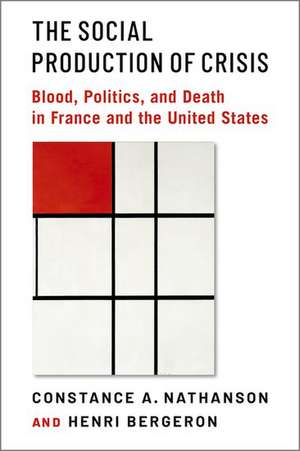The Social Production of Crisis: Blood, Politics, and Death in France and the United States
Autor Constance A. Nathanson, Henri Bergeronen Limba Engleză Hardback – 12 mai 2023
Preț: 365.09 lei
Preț vechi: 502.39 lei
-27% Nou
Puncte Express: 548
Preț estimativ în valută:
69.86€ • 73.09$ • 58.03£
69.86€ • 73.09$ • 58.03£
Carte disponibilă
Livrare economică 01-07 martie
Livrare express 26 februarie-04 martie pentru 93.14 lei
Preluare comenzi: 021 569.72.76
Specificații
ISBN-13: 9780197682487
ISBN-10: 0197682480
Pagini: 264
Ilustrații: 1 b/w line drawing; 1 table
Dimensiuni: 236 x 163 x 24 mm
Greutate: 0.51 kg
Editura: Oxford University Press
Colecția OUP USA
Locul publicării:New York, United States
ISBN-10: 0197682480
Pagini: 264
Ilustrații: 1 b/w line drawing; 1 table
Dimensiuni: 236 x 163 x 24 mm
Greutate: 0.51 kg
Editura: Oxford University Press
Colecția OUP USA
Locul publicării:New York, United States
Recenzii
In this critically important and timely book, Nathanson and Bergeron offer a tale of two countries and their divergent responses to the recognition that HIV had contaminated their blood supplies, placing millions at risk. In the US this story is all but forgotten, a footnote in the wider history of the AIDS epidemic. In France, the debate about HIV in the blood supply became and remains the source of protest, public debate, and political crisis. Essential reading for anyone interested in epidemics, comparative policy, and culture.
In the early 1980s, a contaminated national blood supply led to AIDS infection of over half of hemophiliacs in the U.S. and in France. This book explains-in painstaking detail and with incisive analysis-how and why the same set of events created a national crisis in France and barely a ripple in the United States. A must read!
In this sophisticated and deft analysis, Bergeron and Nathanson ask why, despite the deaths of thousands of hemophiliacs, contamination of the blood supply with HIV did not become a crisis in the US, while a somewhat lower casualty count led to the most serious public health scandal in post-war France and ended multiple political careers. Their answer takes the form of a fascinating, multi-stranded historical narrative that brings together decisions taken after WWII, the symbolic ambiguity of blood and blood products, legal constructs, the power of professional and donor associations, and the rhetorical work of multiple, interested parties. It is essential reading for anyone interested, especially in the wake of the Coronavirus epidemic, in how public health crises are made or unmade.
This exemplary comparative analysis of parallel health crises in France and the United States draws on the best tools available to explain diverging national outcomes. Bringing together a sophisticated political sociology of the state, with cultural, network and strategic action analysis, Nathanson and Bergeron produce a brilliant account that will should inform many other future studies. This book should be widely read and discussed.
In the early 1980s, a contaminated national blood supply led to AIDS infection of over half of hemophiliacs in the U.S. and in France. This book explains-in painstaking detail and with incisive analysis-how and why the same set of events created a national crisis in France and barely a ripple in the United States. A must read!
In this sophisticated and deft analysis, Bergeron and Nathanson ask why, despite the deaths of thousands of hemophiliacs, contamination of the blood supply with HIV did not become a crisis in the US, while a somewhat lower casualty count led to the most serious public health scandal in post-war France and ended multiple political careers. Their answer takes the form of a fascinating, multi-stranded historical narrative that brings together decisions taken after WWII, the symbolic ambiguity of blood and blood products, legal constructs, the power of professional and donor associations, and the rhetorical work of multiple, interested parties. It is essential reading for anyone interested, especially in the wake of the Coronavirus epidemic, in how public health crises are made or unmade.
This exemplary comparative analysis of parallel health crises in France and the United States draws on the best tools available to explain diverging national outcomes. Bringing together a sophisticated political sociology of the state, with cultural, network and strategic action analysis, Nathanson and Bergeron produce a brilliant account that will should inform many other future studies. This book should be widely read and discussed.
Notă biografică
Constance A. Nathanson is currently Professor Emerita at Columbia University. She has over 45 years of experience in research on sociological dimensions of health and health policy. Her work over the past 30 years has focused on the history, politics, and sociology of public health policy and policy change in the United States and in its peer developed countries. Recent publications include articles theorizing policy and policy change in public health from a sociological perspective, more substantive articles on tobacco and gun control policy, the role of social movements in policy change, and essays on health inequalities, as well as a book, Disease Prevention as Social Change (2007), that describes and interprets public health policy shifts across the past two centuries in the United States, France, Great Britain, and Canada.Henri Bergeron is a Senior CNRS Research Professor at the Center for Sociology of Organizations, Sciences Po, Director of the Chair "Transformingorganization" at Sciences Po. He is also co-director of the Health Department of Interdisciplinary Centre for the Evaluation of Public Policies (Centre of Excellence - LABEX), and Scientific coordinator of the Chair in Health Studies-Sciences Po. He is the director of the Master on "Organizational behavior and Human Resources" at Sciences Po and the Scientific Director of the "Management and Public Affairs" track at Sciences Po's School of Public Affairs. He teaches and conducts research on organizational behavior, institutional changes and drivers (including digital transformation), on institutional entrepreneurship, and leadership, and on power in and between organizations (in particular in the field of health).
